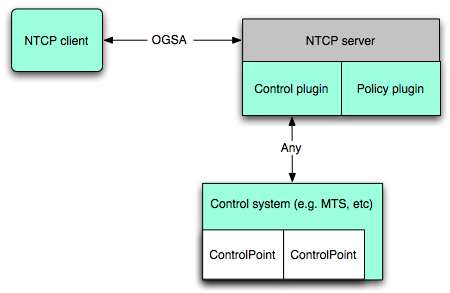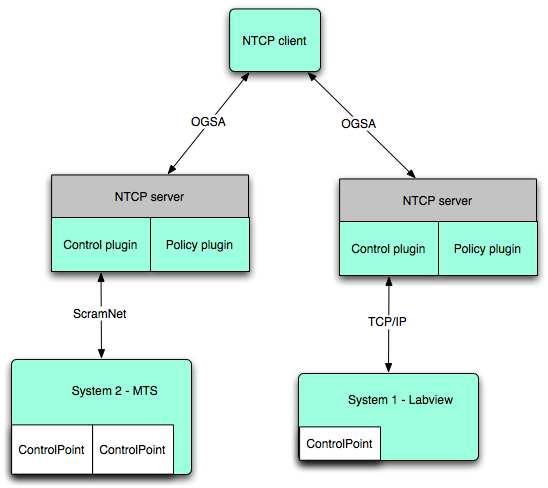Working With Control Plugins
If we revisit the diagram on the first page for moment:

We've now covered the NTCP client in some detail; it's time to look at
the control plugin. This is the way NTCP abstracts differences between
different control systems. There are several shipped with the
distribution that you can use:
- Mplugin, for MATLAB
- ShoreWestern, for use with their control systems
- LabVIEW, for use with any system capable of TCP/IP and ASCII.
More info on this at www.mcs.anl.gov/neesgrid/lv-protocol.html
- Dummy, for testing and as a skeleton
- C plugin, for use with C-language code
Some Basic Information about NTCP and control plugins
- Each NTCP instance has one, and only one, control plugin. The
plugin can talk to whatever it needs to, so a single control plugin
could control more than one piece of equipment. However, as soon as you
need two plugins, you need two NTCP instances:

- NTCP plugins are in a different CVS package from the server
itself, except for one. The C plugin in included with NTCP, and the
rest are in the 'nctp_plugins' CVS package.
- If you want to develop NTCP plugins, you need to install NTCP and
the plugins from CVS; the NEESGrid distribution does not contain the
necessary source code.
- You need to read and understand the NTCP control
plugin API (PDF) completely before
starting.
- As noted in the development introduction, the plugin is selected
at runtime by the contents of server-config.wsdd. We'll look at this
first.
Selecting a Plugin to Run
You'll need to edit server-config.wsdd.
In this example, we'll change from the dummy plugin to the LabVIEW
plugin. As discussed on page two, the
default is the dummy. Open server-config.wsdd in a text editor that
does not wrap text, and search
for 'NTCPServer'. You should see the following:
<service name="nees/ntcp/NTCPServer" provider="Handler" style="wrapped" use="literal">
<parameter name="name" value="NTCP Server"/>
<parameter name="isProfiling" value="false"/>
<parameter name="operationProviders" value="org.globus.ogsa.impl.ogsi.NotificationSourceProvider"/>
<parameter name="persistent" value="true"/>
<parameter name="schemaPath" value="schema/nees/ntcp/ntcp_server_service.wsdl"/>
<parameter name="baseClassName" value="org.nees.ntcp.server.impl.NtcpServerImpl"/>
<parameter name="ntcpBackendFactory" value="org.nees.ntcp.server.backend.test.DummyControlFactory"/>
<parameter name="handlerClass" value="org.globus.ogsa.handlers.RPCURIProvider"/>
<parameter name="authorization" value="none"/>
<parameter name="isSecure" value="false"/>
<parameter name="className" value="org.nees.ntcp.ntcpServer.NtcpServer"/>
<parameter name="localPolicyPlugin" value="org.nees.ntcp.server.backend.test.DummyLocalPolicyPlugin"/>
<parameter name="allowedMethods" value="*"/>
</service>
We're going to do two things: Change the control plugin, and add two
parameters required by the LabVIEW plugin. Since the LV plugin
initiates the connection to the LabVIEW system, it needs to know the
DNS name and TCP port to open. These are contained in lvPort and
lvHost. Here's an example replacement service entry:
<service name="nees/ntcp/NTCPServer" provider="Handler" style="wrapped" use="literal">
<parameter name="name" value="NTCP Server"/>
<parameter name="lvHost" value="130.126.240.141"/>
<parameter name="isProfiling" value="false"/>
<parameter name="operationProviders" value="org.globus.ogsa.impl.ogsi.NotificationSourceProvider"/>
<parameter name="persistent" value="true"/>
<parameter name="lvPort" value="44000"/>
<parameter name="schemaPath" value="schema/nees/ntcp/ntcp_server_service.wsdl"/>
<parameter name="baseClassName" value="org.nees.ntcp.server.impl.NtcpServerImpl"/>
<parameter name="ntcpBackendFactory" value="org.nees.ntcp.plugins.labview.LabviewPluginFactory"/>
<parameter name="handlerClass" value="org.globus.ogsa.handlers.RPCURIProvider"/>
<parameter name="isSecure" value="false"/>
<parameter name="className" value="org.nees.ntcp.ntcpServer.NtcpServer"/>
<parameter name="localPolicyPlugin" value="org.nees.ntcp.server.backend.test.DummyLocalPolicyPlugin"/>
<parameter name="allowedMethods" value="*"/>
</service>
Notes
- the 'isSecure' entry must match what's in the NTCP client. Both
must be either secure or insecure; you cannot mix the two modes.
- lvHost can be numeric, as above, or a normal host name.
- lvPort defaults to 44000, if you change it you have to change the
port the LabVIEW code is using as well.
- Parameter order is not significant.
- If you write your own plugin, you can change ntcpBackendFactory
to the full name of your class. Of course, your class must be deployed
into $OGSA_ROOT, meaning that your jarfile must be in $OGSA_ROOT/lib
Running Multiple NTCP Instances with Different Plugins
If, as is the case with the Mini-MOST, you want to run more than one
instance of NTCP on a single machine with different plugins, there's a
bit of work to do. The underlying problem is this: There is no way to
tell OGSA to use a different server-config.wsdd file.
However, once the container is started, it doesn't re-read the file.
Therefore, all we need to do is something like this:
- Copy saved-wsdd file to server-config.wsdd
- ant startContainer -Dservice.port={first TCP port, e.g. 8090}
- sleep 10-30 seconds, depending on how fast the computer is
- Repeat, with next saved WSDD file.
Consider this a workaround until we find a better method.
The next page deals with
writing your own control plugin; it seemed a logical separation. If you
want to learn about control plugins in C instead of Java, please proceed to this page instead.


